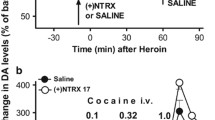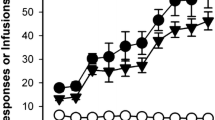Abstract
A quaternary derivative of naloxone, methyl naloxonium chloride (MN), was administered intracerebrally to rats trained to self-administer heroin intravenously. Increases in intravenous (IV) heroin self-administration rates were found following injections of low doses of MN into the nucleus accumbens (N.Acc), but not following injections of low doses of MN into the ventral tegmental area (VTA). These results were interpreted to suggest that the rewarding properties of IV heroin were decreased following N.Acc opiate receptor blockade. The relative insensitivity of the VTA to MN treatment was taken to suggest that VTA opiate receptors are either not essential or play a secondary role in mediating IV heroin self-administration. The present data support the notion that post-synaptic N.Acc opiate receptors play a crucial role in maintaining IV heroin self-administration.
Similar content being viewed by others
References
Bianchi G, Fiocchi R, Tavani A, Manara L (1982) Quaternary narcotic antagonists relative ability to prevent antinociception and gastrointestinal transit inhibition in morphine-treated rats as an index of peripheral selectivity. Life Sci 30:1875–1883
Bozarth MA, Wise RA (1981) Intracranial self-administration of morphine into the ventral tegmental area in rats. Life Sci 28:551–555
Bozarth MA, Wise RA (1983) Neural substrates of opiate reinforcement. Prog Neuropsychopharmacol Biol Psychiatry 7:569–575
Britt MD, Wise RA (1983) Ventral tegmental site of opiate reward: antagonism by a hydrophilic opiate receptor blocker. Brain Res 258:105–108
Ettenberg A, Pettit HO, Bloom FE, Koob GF (1982) Heroin and cocaine intravenous self-administration in rats: Mediation by separate neural systems. Psychopharmacology 78:204–209
Fink JS, Smith GP (1980) Mesolimbocortical dopamine terminal fields are necessary for normal locomotor and investigatory exploration in rats. Brain Res 199:359–385
Glick SD, Cox RS, Crane AM (1975) Changes in morphine self-administration and morphine dependence after lesions of the caudate nukleus in rats. Psychopharmacologia 41:219–224
Goeders NE, Lane TD, Smith JE (1984) Self-administration of methionine enkephalin into the nucleus accumbens. Pharmacol Biochem Behav 20:451–455
Goldberg SR, Woods JH, Schuster CR (1971) Nalorphine-induced changes in morphine self-administration in rhesus monkeys. J Pharmacol Exp Ther 176:464–471
Kalivas PW, Widerlov E, Stanley D, Breese G, Prange AJ Jr (1983) Enkephalin action on the mesolimbic system: a dopamine-dependent and dopamine-independent increase in locomotor activity. J Pharmacol Exp Ther 227(1):1–9
Kelley AE, Stinus L, Iversen SD (1980) Interactions between d-Ala-Met-enkephalin, A10 dopaminergic neurons, and spontaneous behavior in the rat. Behav Brain Res 1:3–24
Koob GF, Bloom FE (1983) Behavioral effects of opioid peptides. Br Med J 39(1):89–94
Koob GF, Pettit HO, Ettenberg A, Bloom FE (1984) Effects of opiate antagonists and their quaternary derivatives on heroin self-administration in the rat. J Pharmacol Exp Ther 229(2):481–486
Kosterlitz HW, Waterfield AA, Berthoud V (1974) Report to the 36th Annual Scientific Meeting. Committee on Drug Dependence. pp 56–65
Olds ME (1982) Reinforcing effects of morphine in the nucleus accumbens. Brain Res 237:429–440
Pellegrino LJ, Pellegrino AS, Cushman AJ (1979) A stereotaxic atlas of the rat brain. Plenum Press New York
Pert A, Sivit C (1977) Neuroanatomical focus for morphine and enkephalin-induced hypermotility. Nature 265:645–647
Pert CB, Pert A, Chang JK, Fong BTW (1976) (D-Ala2)-Metenkephalinamide: A potent, long-lasting synthetic pentapeptide analgesic. Science 194:330–332
Pettit HO, Ettenberg A, Bloom FE, Koob GF (1984) Destruction of dopamine in the nucleus accumbens selectively attenuates cocaine but not heroin self-administration in rats. Psychopharmacology 84:167–173
Pickens R, Meisch RA, Thompson T (1978) Drug self-administration: An analysis of the reinforcing effects of drugs. In: Iversen LL, Iversen SD, Snyder SH (eds) Handbook of Psychopharmacology, vol 12, Plenum Press New York, pp 1–37
Roberts DCS, Corcoran ME, Fibiger HC (1977) On the role of ascending catecholamine systems in intravenous self-administration of cocaine. Pharmacol Biochem Behav 6:615–620
Roberts DCS, Koob GF, Klonoff P, Fibiger HC (1980) Extinction and recovery of cocaine self-administration following 6-hydroxydopamine lesions of the nucleus accumbens. Pharmacol Biochem Behav 12:781–787
Russell J, Bass P, Goldberg LI, Schuster CR, Merz H (1982) Antagonism of gut, but not central effects of morphine with quaternary narcotic antagonists. Eur J Pharmacol 78:255–261
Stinus L, Koob GF, Ling N, Bloom FE, LeMoal M (1980) Locomotor activation induced by infusion of endorphins into the ventral tegmental area: evidence for opiate-dopamine interactions. Proc Natl Acad Sci USA 97:2323–2327
Vaccarino FJ, Franklin KBJ (1982) Self-stimulation and circling reveal functional differences between the medial and lateral substantia nigra. Behav Brain Res 5:281–295
Vaccarino FJ, Pettit HO, Bloom FE, Koob GF (1985) Effects of intra-cerebroventricular administration of methyl naloxonium chloride on heroin self-administration in the rat. Pharmacol Biochem Behav (in press)
Valentino RJ, Katz JL, Medihradsky F, Woods JM (1983) Receptor binding, antagonist, and withdrawal precipitating properties of opiate antagonists. Life Sci 32:2887–2896
Weeks JR, Collins RJ (1976) Changes in morphine self-administration in rats induced by prostaglandin E and naloxone. Prostaglandins 12:11–19
Wilson MC, Schuster CR (1972) The effects of chlorpromazine on psychomotor stimulant self-administration in the rhesus monkey. Psychopharmacologia 26:115–126
Yokel RA, Wise RA (1975) Increased lever pressing for anphetamine after pimozide in rats: implications for a dopamine theory of reward. Science 187:547–549
Yokel RA, Wise RA (1976) Attenuation of intravenous amphetamine reinforcement by central dopamine blockade in rats. Psychopharmacologia 48:311–318
Author information
Authors and Affiliations
Rights and permissions
About this article
Cite this article
Vaccarino, F.J., Bloom, F.E. & Koob, G.F. Blockade of nucleus accumbens opiate receptors attenuates intravenous heroin reward in the rat. Psychopharmacology 86, 37–42 (1985). https://doi.org/10.1007/BF00431681
Received:
Accepted:
Issue Date:
DOI: https://doi.org/10.1007/BF00431681




